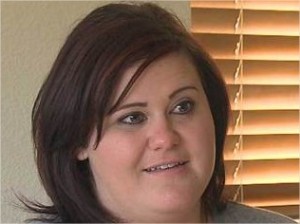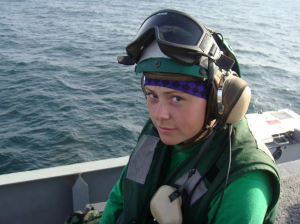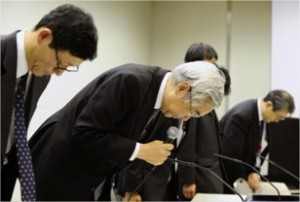When Japan’s Fukushima nuclear plant released radioactive plumes to the air, US sailors were there to help. Now, as some grow seriously ill from illnesses consistent with radiation exposure, who is helping them?

“You always hurt the one you love, the one you shouldn’t hurt at all”
If there’s any truth to that pop standard’s message, then America must surely love its heroes. Because, much as we lionize those who stare death in the face so that the rest of us may live peacefully, once the spotlight shifts away from the heroes of each war or disaster, as often as not our government officials callously toss those heroes aside.
The list is long and dates from the Bonus Army of jobless World War I veterans attacked in 1932 by the Washington, DC, police for demanding compensation for wartime service, to the Iraq and Afghanistan veterans who suffered neglect and shoddy conditions at Walter Reed Army Medical Center as recently as 2007. There are plenty of stops in between: The Vietnam vets never properly compensated for exposure to Agent Orange; Gulf War veterans who waited 17 years for Congress to acknowledge the reality of Gulf War Syndrome; and the 9/11 responders who waited eight years for whatever the budget cutters in Washington were willing, in their generosity, to dispense.
This sorry list is about to grow with the addition of scores of U.S. sailors who went on an idealistic mission three years ago to help the Japanese cope with the destruction from the strongest earthquake in the country’s history—the 9.0 magnitude earthquake and subsequent 50-foot tsunami on March 11, 2011 that turned much of the northeastern coast of Japan into rubble and swamped the Fukushima nuclear power plant. The combined events knocked out all electricity to the plant, and within five hours, the first of three reactors that ultimately did so began melting down.
At least 79 of those sailors now suffer serious health effects consistent with radiation exposure. Some of the sailors have filed a class action lawsuit against the Japanese power company, accusing it of hiding what it knew about the escaping radiation and seeking unspecified compensatory and punitive damages, as well as $1 billion for a fund to cover their medical monitoring and treatment. Some of them also blame the U.S. Navy, which denies that its sailors were exposed to harmful levels of radiation.
They Came Out Cooked
Paul Garner, the lead attorney on the case, told WhoWhatWhy that a much larger group of military personnel were exposed to radiation, and he expects the number signing on to the lawsuit to rise as more people develop symptoms. He reeled off a long list of alarming health complaints among the nearly 100 former Operation Tomodachi participants he’s interviewed. So far, about half have developed cancer—of the brain, eye, testes, thyroid, or blood (leukemia). “These kids were first responders,” Garner says. “They went in happily doing a humanitarian mission, and they came out cooked.”
Radiation Déjà vu
The situation these sailors find themselves in is all too familiar in the annals of the nuclear age. Over the past 75 years, claims of harm by many people exposed to radiation through no fault of their own have been officially downplayed or denied. For example: Victims of fallout from atom bomb testing, workers routinely exposed at a nuclear weapons facility, people living near one, and those caught downwind of reactor meltdowns at nuclear power plants, as in the 1979 Three Mile Island accident in Pennsylvania and the 1986 Chernobyl reactor explosion.
The U.S. Department of Defense claims to have calculated “whole-body and thyroid radiation doses” for nearly 75,000 DOD-affiliated individuals who were on or near the mainland of Japan during the period from March 12, 2011 to May 11, 2011. Its determination: “Your whole-body and thyroid radiation dose estimates are well below levels associated with adverse medical conditions.”
Official Estimates Don’t Compute
A DOD report lays out how the Navy reached its conclusions about the doses that 17,000-plus sailors received. But according to nuclear engineer Arnie Gundersen, a former industry vice president who blew the whistle on radiation safety violations at his former employer, Nuclear Energy Services, as with the previous accidents at Three Mile Island and Chernobyl, nobody knows how much radiation has been released from Fukushima—because most of the radiation monitors did not survive the accidents. That means assumptions rather than real data were used to calculate the total amount of radiation released—resulting in estimates that Gundersen believes are much too low.
Another outside expert charges the Navy’s reconstructed doses are meaningless. Robert Alvarez, a senior scholar at the Institute for Policy Studies and former deputy assistant secretary at the Department of Energy, who has spent several years auditing radiation dose reconstructions on ailing U.S. nuclear weapons workers, says the only way to get an accurate internal and external dose on any individual is to take continual measurements throughout the time they are exposed. People must wear special monitoring equipment and undergo a regular regime of monitoring. This is especially important in trying to assess the health effects from a multiple meltdown situation with large explosions involving reactor cores, as occurred at Fukushima.
Alvarez says that based on the illnesses that Operation Tomodachi participants are reporting, the real radiation doses were likely very large. “We’re hearing the same kinds of complaints that I was hearing from the people exposed to fallout from the bomb testing program—the metallic taste in the mouth, loss of hair, and sudden and unexpected illnesses,” he says. Symptoms like that indicate “tissue-destructive doses.”
A February 2014 report by Kyle Cleveland, an American sociologist at Temple University in Japan, confirms Alvarez’s assessment. The report includes a transcribed telephone conversation Cleveland received from a Freedom of Information Act (FOIA) request, which reveals that monitors aboard the aircraft carrier USS Ronald Reagan picked up radiation levels 30 times higher than normal out at sea 100 miles from the reactors. The nuclear expert quoted in the transcript was surprised to detect anything at that distance and says radiation levels were high enough to damage people’s thyroids after ten hours of exposure.
If the Navy’s questionable dismissal of radiation exposure is troubling, the actions of the Tokyo Electric Power Company are even more so. The Japanese Diet (Japan’s parliament) tasked an independent commission, known officially as the Fukushima Nuclear Accident Independent Investigation Commission, with figuring out what caused the multiple meltdown.
The report, released in 2012, is damning in its conclusions. Unlike the U.S. Navy, the Commission characterizes Fukushima as a “severe accident that ultimately emitted an enormous amount of radioactive material into the environment.”
Scrubbing the Deck in the Danger Zone
Meanwhile, heroes like Lindsay Cooper live with the consequences of that accident. Cooper spent nearly two months on the flight deck of the Reagan, repeatedly exposed to radiation plumes from the destroyed reactors. On arriving in Japan just off the coast before dawn on March 12, 2011, Cooper confronted a surreal scene. “You couldn’t even really tell there was an ocean,” she told WhoWhatWhy. “It was a sea of wood.”

After ship commanders became aware of the first radiation plume to hit the ship, they limited the number of people allowed on the flight deck where radiation exposure was highest. Consequently, sailors whose work required them to be on deck spent even longer periods of time at risk. The only protection from radiation they received were rubber boots that went over their regular boots. Judy Goodwin, who served with Cooper on that deck, says the sailors were assured they were not being exposed to anything dangerous and that the decontamination procedures they were subjected to were “simply precautionary.”

After two or three weeks, Cooper says, people started getting sick. She witnessed crewmembers running and vomiting over the side of the flight deck, because they couldn’t wait in the long lines to go through decontamination before being allowed to get to the bathroom.
Nearly three years later, Cooper, 24, suffers from a severely dysfunctional menstrual cycle, a problem that began about a month after she arrived in Japan. She also regularly gains 40 to 50 pounds over the course of a month and then loses it. Veterans Administration doctors attribute her severe problems to nothing other than “stress.”
After Goodwin, 26, was discharged from the Navy in late 2011, she lost 30 pounds and had to have her gallbladder removed, because, her doctor told her, it just stopped working. She also has problems with her liver. The Veterans Administration has denied her claim for disability based on radiation exposure, because it says there isn’t enough proof.
National VA spokesperson Gina Jackson told WhoWhatWhy she couldn’t comment on either of these cases without privacy waivers from the two sailors. But generally speaking, each vet’s claims are evaluated individually, and if their medical problem is determined to have been caused by their military service, they are awarded disability.
Despite repeated requests, neither Cooper nor Goodwin has been given access to their Navy medical files. Cooper did receive a “purged” file that contains records from her boot camp training—but nothing about her tour on the Reagan.
An Odd Constellation of Symptoms
Navy ensign Steve Simmons, now 36, headed the department that processed the paperwork documenting the flight of any aircraft on or off the ship. His office and sleeping quarters were located just below the entrance to the flight deck. Once the mission ended and restrictions to the flight deck were lifted, he worked out on an exposed weather deck, and tried to get up to the flight deck at least twice a day.

It wasn’t until the previously fit and healthy sailor started having bizarre health problems that he would think about the radiation exposure again. He has experienced an unexplained blackout, a persistent fever of 102.9℉, swollen lymph nodes, unusual sun sensitivity that landed him in the emergency room with third degree burns, and loss of balance and the strength in his legs. Now confined to a wheelchair and with bladder dysfunction, he has to insert a catheter into his urethra every four hours to empty his urine.
None of the military doctors attribute his maladies to radiation exposure. In fact, he says, they seemed to go out of their way to deny any connection. He’s not buying the Navy’s insistence that the maximum amount of radiation these sailors were exposed to was “less than 25 percent of the annual radiation exposure to a member of the U.S. public from natural sources of background radiation, such as the sun, rocks and soil.”
“If that’s truly the case,” Simmons asks, “why are they classifying Fukushima as either the worst nuclear disaster in history or the worst nuclear disaster since Chernobyl? How is it possible that there was absolutely no threat to human life? Why are there scientists out there saying that the land in that area is going to be uninhabitable for hundreds of years?”
Navy spokesman Lt. Greg Raelson says the Navy’s conclusions about the impact of Fukushima are based on the tri-service Dose Assessment and Registry Working Group, a peer-reviewed report, which determined that “the highest whole body dose to any crewmember is much lower than levels of radiation exposure associated with the occurrence of long-term health effects.”
Referencing the National Academy of Science’s Biological Effects of Ionizing Radiation (BEIR) reports, he says many studies that examined the time between radiation exposure and the development of an effect, such as cancer, take much longer to show up—typically two years in the case of non-solid cancers like leukemia and at least ten years for solid malignancies, like thyroid cancer. “There is no indication that radiation exposure to U.S. personnel supporting Operation Tomodachi presented any risks greater than [what is] normally accepted during everyday life,” he said.
From Fitness Instructor to Near Invalid
When the earthquake hit, Mike Sebourn was the senior chief mechanic in the helicopter squadron at the Navy’s Atsugi air base in Japan. At the time, he was also a fitness instructor, strong and healthy. But a few weeks after the disaster, he began having nosebleeds and migraines. They went away, but four months later, he discovered he could lift only 60 percent of what he could lift previously.

Sebourn had been in charge of decontaminating helicopters that were coming back after flying relief missions through radioactive plumes. The Navy didn’t prepare him for the job, he told WhoWhatWhy. What normally would have been a two-year course in radiation remediation was distilled down to two days. The course contained no discussion on the health risks involved; however, they were assured that their exposures would be monitored and noted in their military files.
Lt. Raelson was not able to comment on Sebourn’s description of his radiation remediation training, because he said he could not verify what training Sebourn did or did not receive.
After the relief missions ended, Sebourn said, he didn’t use much protective gear at all because radiation readings they got off the skin of the aircraft weren’t high enough to warrant it. However, he now believes he continued to be exposed to dangerous levels of radiation, mainly from hot components inside the aircraft. Sebourn, 39, now suffers from extreme loss of muscle mass and deterioration in the strength of his muscles on the right side of his body.
Because of his escalating physical problems, he changed his military status from enlisted to commissioned officer on the promise that he and his family would be redeployed to the U.S. But his officer’s orders kept him in Japan, so he decided to leave the Navy.
“After giving them 17 years of my life and putting the needs of the Navy before everything else—before my family and myself—I have no retirement, no medical benefits, nothing,” he said. As a result of his medical problems, Sebourn has received a 60 percent disability rating, which entitles him to a modest monthly stipend. He also receives GI benefits and is using that for school, training to be a network systems administrator. Despite his Navy job as a designated radiation decontamination officer, he says there is no mention of radiation exposure in his military medical file.
What Did the U.S. Navy Know?
Whether the plaintiffs succeed in holding the Japanese utility liable, the case raises important questions about the role and responsibility of the U.S. Navy:
Why did the U.S. Navy insist from the beginning that it was safe for its troops to remain in the vicinity of three reactor meltdowns?
After having gone to the trouble of setting up a medical registry to track radiation-related illnesses—the Operation Tomodachi Registry—why did the U.S. Department of Defense decide not to monitor the health of the nearly 75,000 DOD-affiliated citizens—military personnel and their family members—who were in or near Japan during and after the Fukushima meltdowns?
Why is there no mention of radiation exposure in many of the sailors’ military medical files, even those people specifically assigned jobs involving radiation decontamination?
Why, given the mounting evidence of illnesses known to be triggered by radiation exposure, is radiation dismissed as a possible cause?
In response to the first question, Lt. Raelson denies that Operation Tomodachi personnel were close enough to the three melting Fukushima reactors to have been exposed to dangerous levels of radiation: “Specifically, all ships were kept at least 100 miles away from the Fukushima reactors, and aircraft supporting disaster relief flights were kept at an appropriate distance from the reactors.”
Furthermore, he says the Navy’s ships and aircraft were fully equipped to “reduce, eliminate, and control radioactive contamination” and did so. Potentially contaminated personnel—flight crews, those “who approached the area around Fukushima Daiichi,” those carrying out decontamination, and others—were carefully monitored with “sensitive whole body dosimeters” and, if necessary, decontaminated.
As to why the government scrapped plans to monitor the health of the U.S. citizens and family members who were in or around Japan during the early days of the triple meltdown, Lt. Col. Cathy Wilkinson, a spokesperson for the U.S Department of Defense, which runs the registry, told WhoWhatWhy that as far as she knows, the registry was only ever intended to document the exposures of the DoD-affiliated population in Japan. “This gives you the baseline—yes, you were there, it’s your official documentation of your estimated exposure,” she said. Beyond that, individuals are responsible for obtaining their own healthcare.
Regarding documentation of radiation exposure, Lt. Raelson said: “The Naval Dosimetry Center (NDC) maintains long-term records of occupational exposure to ionizing radiation derived from TLDs and other dosimeters. Any service member can request his or her dose history in writing from NDC.”
In answer to why radiation was dismissed as a possible cause to illnesses known to be triggered by radiation exposure that sailors are now reporting, he reiterated that the tri-service Dose Assessment and Registry Working Group studied the available data and concluded that no crewmember was exposed to anything higher than what they would ordinarily receive as inhabitants of planet Earth: “For perspective, the worst-case radiation exposure for a crewmember on USS Ronald Reagan is less than 25 percent of the annual radiation exposure to a member of the U.S. public from natural sources of background radiation, such as the sun, rocks, and soil.”
Legal Remedy Sought
Meanwhile, the only remedy available to Cooper, Goodwin, Sebourn, Simmons, and the others is to sue the Japanese operator of the nuclear plant, TEPCO. Lead attorney for the class action suit, Paul Garner, believes he will be able to prove that TEPCO knew on the first day of the accident that the plant was spewing deadly radiation, but concealed that information from the world. He also expresses confidence he will be able to prove that if the military had been aware of the radiation levels, it would not have sent or kept U.S. troops in harm’s way.

But Judge Janis L. Sammartino, who is hearing the case in San Diego, has set a high bar, ruling in November 2013 that the plaintiffs must show:
…not only that TEPCO misrepresented the condition of the FNPP [Fukushima nuclear power plant] and the risk to soldiers operating near the damaged facility, but also that TEPCO’s allegedly wrongful conduct, as opposed to other factors, caused the commanding officers of the Reagan “(1) to move the strike force and associated personnel into an area of dangerous radiation exposure; (2) to do so without undertaking radiation testing and research; and (3) to fail to order the necessary precautions, such as locking down the Reagan and supplying radiation monitoring.…”
And further:
At a minimum, Plaintiffs must show that, but for TEPCO’s allegedly wrongful conduct, the military would not have deployed personnel near the FNPP or would have taken additional measures to protect service members from radiation exposure. Thus, Plaintiffs’ success inevitably hinges on the conclusion that the military’s precautions were inadequate or unreasonable and that had it not been for TEPCO’s misstatements, military commanders would have adopted a different course of action.
Reason for Navy Cover-up?
Because U.S. military personnel are prevented from suing the government, their only recourse is to go after TEPCO. But given the interests involved, the outcome for the Operation Tomodachi victims remains very much in doubt. Robert Alvarez, the nuclear investigator and former DOE deputy assistant secretary, points out that about a quarter of a million U.S. soldiers were subjected to open air nuclear weapons testing in the 1940s, 50s and 60s.
“If you use the treatment of atomic veterans who were involved in atmospheric testing as a benchmark, the government did everything it could to downplay the hazards, because from the military perspective, the mission is all important,” he says.
“Right now, the United States government and Japan are closing ranks because of their nuclear-related relationships,” he says. Although Japan’s 54 power-generating nuclear reactors are currently offline, the country still has the third largest number of nuclear reactors in the world.
But more important, Alvarez says, is the “extraordinary co-dependence” with Japan on nuclear-energy-related matters. “Because the U.S. has lost much of its capability in designing and building reactors, we have to depend on the Japanese and the French if we’re going to build any reactors or fabricate fuel or do anything to service the existing reactor fleet,” he explained. “We’re dependent on companies that are now owned by Japan and France.”
The case of the ill Operation Tomodachi veterans shines a spotlight on the intersection of competing interests between victims of radiation exposure, the nuclear power industry, and the U.S. government and its unwavering commitment to nuclear technology for both military and civilian use.
 So far, by denying the harm from the radiation U.S. military personnel were exposed to as they helped Japan clean up after the devastating earthquake and tsunami in March 2011—a position that supports the Japanese government and nuclear industry—the U.S. government is doing what it has almost always done: protect nuclear interests rather than its victims.
So far, by denying the harm from the radiation U.S. military personnel were exposed to as they helped Japan clean up after the devastating earthquake and tsunami in March 2011—a position that supports the Japanese government and nuclear industry—the U.S. government is doing what it has almost always done: protect nuclear interests rather than its victims.
As the number of ill Operation Tomodachi veterans climbs, it remains to be seen whether their sacrifice will be acknowledged or if they, like so many others, will be left to fend for themselves.
[box] WhoWhatWhy plans to continue doing this kind of groundbreaking original reporting. You can count on us. Can we count on you? What we do is only possible with your support.
Please click here to donate; it’s tax deductible. And it packs a punch.[/box]


